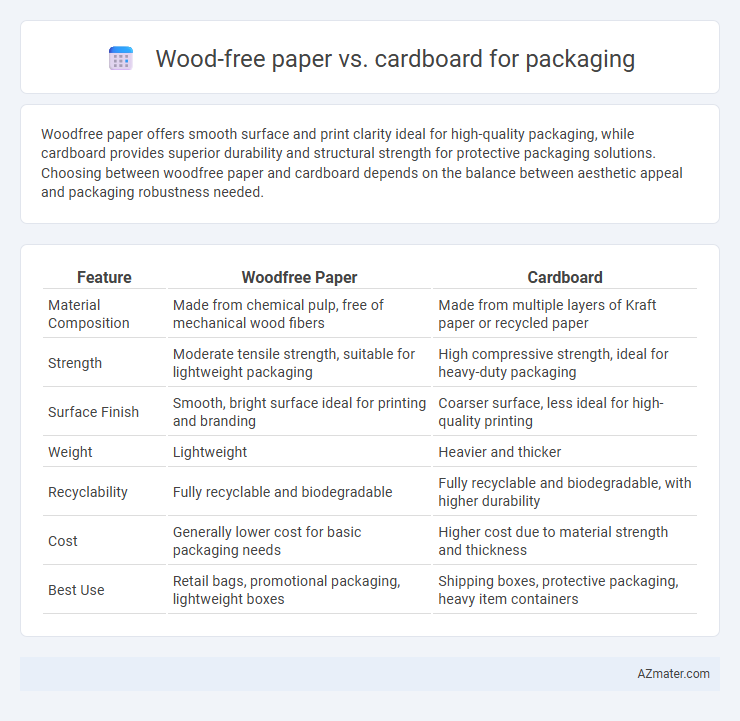Woodfree paper offers smooth surface and print clarity ideal for high-quality packaging, while cardboard provides superior durability and structural strength for protective packaging solutions. Choosing between woodfree paper and cardboard depends on the balance between aesthetic appeal and packaging robustness needed.
Table of Comparison
| Feature | Woodfree Paper | Cardboard |
|---|---|---|
| Material Composition | Made from chemical pulp, free of mechanical wood fibers | Made from multiple layers of Kraft paper or recycled paper |
| Strength | Moderate tensile strength, suitable for lightweight packaging | High compressive strength, ideal for heavy-duty packaging |
| Surface Finish | Smooth, bright surface ideal for printing and branding | Coarser surface, less ideal for high-quality printing |
| Weight | Lightweight | Heavier and thicker |
| Recyclability | Fully recyclable and biodegradable | Fully recyclable and biodegradable, with higher durability |
| Cost | Generally lower cost for basic packaging needs | Higher cost due to material strength and thickness |
| Best Use | Retail bags, promotional packaging, lightweight boxes | Shipping boxes, protective packaging, heavy item containers |
Introduction to Packaging Materials
Woodfree paper, characterized by its high-quality, chemical pulp content and absence of mechanical fibers, offers a smooth surface ideal for printing and lightweight packaging. Cardboard, composed of multiple layers of paper pulp including a corrugated middle layer, provides superior strength and cushioning, making it suitable for protective packaging. Selecting between woodfree paper and cardboard depends on the packaging requirements for durability, printability, and environmental impact.
What is Woodfree Paper?
Woodfree paper is a high-quality paper made primarily from chemical pulp, which has most of the lignin removed to improve strength, brightness, and smoothness. Unlike cardboard, which consists of multiple layers of coarse pulp for rigidity, woodfree paper provides a smooth, durable surface ideal for printing and packaging that requires fine detail. This type of paper is commonly used in premium packaging, labels, and printing applications due to its superior whiteness and printability compared to conventional papers.
What is Cardboard?
Cardboard is a thick, rigid material made from multiple layers of paper pulp, commonly used for packaging due to its durability and protective qualities. It often consists of corrugated fiberboard, which provides cushioning and strength essential for shipping and storing goods. Unlike woodfree paper, which is smooth and uncoated for printing, cardboard is designed to withstand impact and support heavy loads in packaging applications.
Material Composition: Woodfree Paper vs Cardboard
Woodfree paper primarily consists of chemical pulp with most lignin removed, resulting in a smooth, high-quality surface ideal for printing and lightweight packaging. Cardboard is made from multiple layers of coarse paper pulp, often including recycled fibers, making it thicker, sturdier, and better suited for protective packaging. The fundamental difference lies in woodfree paper's refined cellulose content versus cardboard's layered, fibrous structure designed for durability and cushioning.
Durability and Strength Comparison
Woodfree paper offers a smooth surface and moderate strength, making it suitable for lightweight packaging but less resistant to tearing and impact compared to cardboard. Cardboard, especially corrugated varieties, provides superior durability and structural strength, ideal for protecting heavy or fragile items during shipping and handling. The thickness and multi-layer construction of cardboard enhance its rigidity and cushioning properties, outperforming woodfree paper in maintaining package integrity under stress.
Printing Quality and Surface Finish
Woodfree paper offers superior printing quality due to its smooth, high-brightness surface that enhances color vibrancy and sharpness, making it ideal for detailed graphics and fine text. Cardboard, while more robust for packaging durability, typically has a rougher surface that can lead to less crisp printing and muted colors, requiring specialized coatings or treatments for premium finishes. For packaging applications demanding high visual appeal and precise print reproduction, woodfree paper is preferred, whereas cardboard suits structural integrity with moderate print quality.
Environmental Impact and Sustainability
Woodfree paper, typically produced from chemical pulp with fewer lignins, offers smoother surfaces ideal for high-quality printing and is biodegradable but may still involve significant chemical processing impacting the environment. Cardboard, often made from recycled fibers and designed for strength, provides superior durability and is highly recyclable, reducing the need for virgin materials and minimizing landfill waste. Choosing cardboard over woodfree paper for packaging generally enhances sustainability due to its higher recycled content and better end-of-life recyclability, contributing to lower carbon footprints and resource conservation.
Cost Effectiveness in Packaging
Woodfree paper offers a cost-effective solution for packaging due to its smooth texture, lightweight nature, and suitability for high-speed printing, which reduces production expenses. Cardboard, while generally more expensive, provides superior durability and protection, making it a cost-efficient choice for packaging heavy or fragile items. Selecting between woodfree paper and cardboard depends on balancing budget constraints with packaging needs, where woodfree paper is ideal for lightweight, economical packaging and cardboard excels in strength and protection.
Best Use Cases for Woodfree Paper
Woodfree paper is ideal for high-quality printing, promotional materials, and premium packaging applications where smooth surface and bright, white finish enhance visual appeal. It performs best in luxury product packaging, brochures, and labels that require sharp image reproduction and a refined tactile experience. Woodfree paper's smooth texture and superior ink absorption make it less suitable for heavy-duty or structural packaging compared to cardboard.
Ideal Applications for Cardboard Packaging
Cardboard packaging excels in protecting heavy or fragile items during shipping due to its sturdy, rigid structure and excellent cushioning properties. It is ideal for e-commerce boxes, food containers, and retail packaging where durability and printability for branding are crucial. Unlike woodfree paper, cardboard offers superior impact resistance and environmental sustainability through recyclability, making it preferred for bulk and industrial packaging solutions.

Infographic: Woodfree paper vs Cardboard for Packaging
 azmater.com
azmater.com